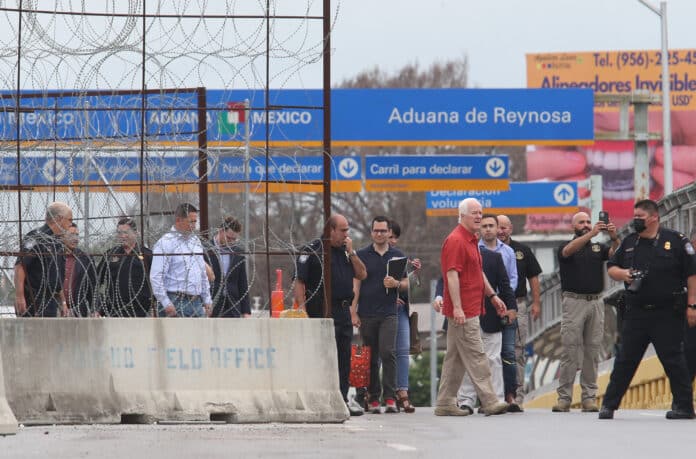
HIDALGO — Two months after proposing bipartisan legislation addressing the migration influx at the border, four lawmakers on both sides of the aisle visited the Rio Grande Valley to seek support from local elected officials, stakeholders and law enforcement.
In late April, U.S. Sen. John Cornyn sponsored the Bipartisan Border Solutions Act of 2021 and introduced it with cosponsor U.S. Sen. Kyrsten Sinema, a Democrat from Arizona. Border congressmen and U.S. Reps. Henry Cuellar, D-Laredo, and Tony Gonzalez, a Republican, publicly endorsed it. These four made up Wednesday’s bipartisan delegation in the Valley.
Minutes before the legislators walked toward the long line of pedestrians waiting to cross into the U.S. at the Hidalgo-Reynosa International Bridge, a group of migrants who were expelled from the country exited a white bus and began their journey toward Mexico, a picture that addressed both reasons they visited South Texas.
“All we’re asking for is balance between commerce, tourism and security,” Cuellar said during a news conference at the bridge.
Earlier in the day, the delegation visited Border Patrol’s temporary processing center and the Health and Human Services’ emergency intake site in Donna. Then they met with local elected officials and law enforcement at the bridge.
“We thought it was important working together in a bipartisan and bicameral way — in other words, in the Senate and the House — to come up with a solution that we think will contribute to making progress,” Cornyn said Wednesday.
The bill encourages the creation of four large regional processing centers in the busiest parts of the border. Personnel from U.S. Customs and Border Protection, Immigration and Customs Enforcement, as well as FEMA, U.S. Citizenship and Immigration Services and the Office of Refugee Resettlement will be expected to perform criminal history checks, verify identification, collect and analyze biometrics, medical screenings, and provide legal orientation programming and access to outside legal counsel, and conduct asylum interviews and credible fear determinations.
“We seek practical, common sense solutions,” Sinema said.
Other proposed changes seek to expedite the asylum process through pilot programs and prioritized docketing of cases for removal of migrants who enter the country illegally.
Since the introduction of the bill, the Department of Justice and the Department of Homeland Security announced the creation of a dedicated docket that will expedite cases of certain migrant families who entered the border through ports of entry.
“Families may qualify if they are apprehended between ports of entry on or after Friday, May 28, 2021, placed in removal proceedings, and enrolled in Alternatives to Detention,” a news release from last week stated.
The program is set to start in 10 cities across the country, though none are in the Valley. Families who are moved ahead of the line will have a decision from the immigration judge 300 days after the last hearing.
“I’m glad that the administration is taking our idea,” Cuellar said. He emphasized that 300 days is too long, and said they seek to have faster decisions.
They want to add 150 more immigration judge teams, 300 asylum officers, and processing coordinators across several federal agencies.
“Now, our piece of legislation is not the end all be all,” Sinema said. “But it is a practical step that addresses much of the current crisis we face and we look forward to garnering support from allies and colleagues on both sides of the aisles as we return to Washington.”
So far, several organizations including the U.S. Chamber of Commerce, National Border Patrol Council, U.S. Hispanic Chamber of Commerce, and the Texas Border Sheriff’s Coalition have endorsed the bill.
The legislation was introduced April 22, but action has yet to be taken on it.
Editor’s note: This story was updated to clarify the time between legislators walked toward the pedestrians and when the migrants exited the bus.



